 W
WThe Golden Horn is a major urban waterway and the primary inlet of the Bosphorus in Istanbul, Turkey.
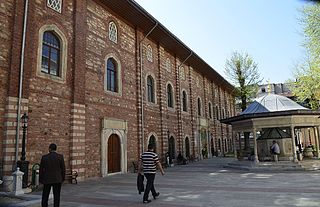 W
WArap Mosque is a mosque in the Karaköy quarter of Istanbul, Turkey. The building was originally a Roman Catholic church erected in 1325 by the friars of the Dominican Order, near or above an earlier chapel dedicated to Saint Paul in 1233. Although the structure was altered during the Ottoman period, it is the only example of medieval religious Gothic Architecture remaining in Istanbul.
 W
WAtatürk Bridge, alternatively known as the Unkapanı Bridge, is a highway bridge on the Golden Horn in Istanbul, Turkey. It is named after Mustafa Kemal Atatürk, the founder and first President of the Republic of Turkey.
 W
WAtik Mustafa Pasha Mosque is a former Eastern Orthodox church in Istanbul, converted into a mosque by the Ottomans. The dedication of the church is obscure. For a long time it has been identified with the church of Saints Peter and Mark, but without any proof. Now it seems more probable that the church is to be identified with Saint Thekla of the Palace of Blachernae. The building belongs stylistically to the eleventh-twelfth century.
 W
WAynalıkavak Pavilion is a former Ottoman pavilion located in the Hasköy neighborhood of Beyoğlu district in Istanbul, Turkey. It was constructed during the reign of Sultan Ahmed I (1603-1617), with various additions and changes over time. It is under the administration of the Turkish Directorate of National Palaces.
 W
WAyvansaray is a neighborhood in Istanbul, Turkey. It is part of the district of Fatih and part of the walled city. It lies between the southern shore of the Golden Horn, the Blachernae section of the Walls, and the neighborhoods of Balat and Edirnekapı. It corresponds to the old quarter of Blachernae. The name Ayvansaray is from Persian ایوانسرای and means "Veranda Palace". This name hearkens back to the Palace of Alexios I Komnenos, which was part of the complex of Blachernae.
 W
WBulgarian St Stephen Church, also known as the Bulgarian Iron Church, is a Bulgarian Orthodox church in Balat, Istanbul, Turkey. It is famous for being made of prefabricated cast iron elements in the neo-Gothic style. The church belongs to the Bulgarian minority in the city.
 W
WThe Church of St. George is the principal Eastern Orthodox cathedral still in use in Istanbul, the largest city in Turkey and, as Constantinople, capital of the Byzantine Empire until 1453. Since about 1600, it has been the seat of the Ecumenical Patriarchate of Constantinople whose leader is regarded as the primus inter pares in the Eastern Orthodox Church, and as the spiritual leader of 300 million Orthodox Christians worldwide.
 W
WEdirnekapı is a quarter of Istanbul, Turkey. It is part of the district of Fatih and belongs to the walled city.
 W
WEminönü is a former district of Istanbul in Turkey, currently a quarter within the Fatih district, which is the capital district of Istanbul and of Istanbul Province. Eminönü covers roughly the area on which the ancient city of Byzantium was built. The Galata Bridge crosses the Golden Horn and connects Karaköy at north with Eminönü at south. Eminönü is located at the point where the Golden Horn connects with the southern entrance of the Bosphorus strait, near the Sea of Marmara. Up on the hill stands Topkapı Palace, the Blue Mosque and Hagia Sophia. It was a part of the Fatih district until 1928, which covered the whole peninsular area within the Roman city walls - that area which was formerly the Byzantine capital Constantinople. Since the resident population of Eminönü is low today, it rejoined the capital district Fatih in 2009.
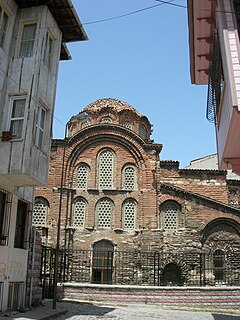 W
WEski Imaret Mosque is a former Eastern Orthodox church converted into a mosque by the Ottomans. The church has traditionally been identified with that belonging to the Monastery of Christ Pantepoptes, meaning "Christ the all-seeing". It is the only documented 11th-century church in Istanbul which survives intact, and represents a key monument of middle Byzantine architecture. Despite that, the building remains one among the least studied of the city.
 W
WEyüp or Eyüpsultan is a municipality (belediye) and district of the city of İstanbul, Turkey. The district extends from the Golden Horn all the way to the shore of the Black Sea. Eyüp is also the name of a prominent neighborhood and former village in the district, located at the confluence of the Kâğıthane and Alibey streams at the head of the Golden Horn. The Eyüp neighborhood is a historically important area, especially for Turkey's Muslims. It became district centre in 1936, after some parts of Fatih, Çatalca and Sarıyer was joined together; later for some time it also included Gaziosmanpaşa and Bayrampaşa districts. Its present boundaries were established after the borough of Yayla was given to Sultangazi in 2009. Its neighbours are Sarıyer in the east, Kâğıthane and Beyoğlu in the southeast, Gaziosmanpaşa, Fatih and Sultangazi in the south, Başakşehir in the southwest and Arnavutköy in the west, It was named after Abu Ayyub al-Ansari by the Ottoman Turks.
 W
WThe Eyüp Cemetery, aka Eyüp Sultan Cemetery, is a historic burial ground located in the Eyüp district, on the European side of Istanbul, Turkey. It is administered by the General Directorate of Foundations. One of the oldest and largest Muslim cemeteries in Istanbul, it hosts graves of Ottoman sultans and court members, grand viziers, high-ranked religious authorities, civil servants and military commanders as well as intellectuals, scientists, artists and poets.
 W
WThe Eyüp Gondola, a.k.a. Eyüp–Piyerloti Aerial Cable Car, is a two-station gondola-type line of aerial lift passenger transport system located in Eyüp district of Istanbul, Turkey. Opened on November 30, 2005, the 384 m (1,260 ft) long line serves the Piyerloti Hill from Eyüp at the coast of Golden Horn. It is operated under the line number Tf2 by Istanbul Transport Company, a subsidiary of Istanbul Metropolitan Municipality. The fare is paid by the contactless smart card of Istanbulkart, which is valid at all public transport in Istanbul.
 W
WThe Eyüp Sultan Mosque is an identical mosque situated in the Eyüp district of Istanbul, outside the city walls near the Golden Horn. The present building dates from the beginning of the 19th century. The mosque complex includes a mausoleum marking the spot where Abu Ayyub al-Ansari, the standard-bearer and friend of the Islamic prophet Muhammad, is said to have been buried.
 W
WFener is a quarter midway up the Golden Horn within the district of Fatih in Istanbul, Turkey. The streets in the area are full of historic wooden mansions, churches, and synagogues dating from the Byzantine and Ottoman eras. The wooden mansions between the main axis and the shore were often used for importing wood from Pontus or the Black Sea area. Their picturesque facades were largely destroyed due to street widening requirements in the 1930s and later. The area's name is a Turkish transliteration of the original word "fanarion" It was so called for a column topped with a lantern which stood there in the Byzantine period – used as a public light or marine and/or other purpose locator/beacon.
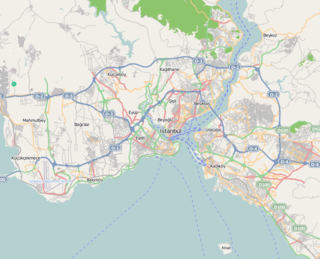 W
WThe Fil Bridge, also known as Silahtarağa Bridge is a 38 m (125 ft) long, concrete bowstring bridge that crosses the Alibeyköy Creek in Istanbul, Turkey. The bridge was completed in 1932 by the Istanbul Metropolitan Municipality.
 W
WGalata is the former name of the Karaköy neighbourhood in Istanbul, which is located at the northern shore of the Golden Horn. The district is connected to the historic Fatih district by several bridges that cross the Golden Horn, most notably the Galata Bridge. The medieval citadel of Galata was a colony of the Republic of Genoa between 1273 and 1453. The famous Galata Tower was built by the Genoese in 1348 at the northernmost and highest point of the citadel. Galata is now a quarter within the district of Beyoğlu in Istanbul.
 W
WThe Galata Bridge is a bridge that spans the Golden Horn in Istanbul, Turkey. From the end of the 19th century in particular, the bridge has featured in Turkish literature, theater, poetry and novels.
 W
WThe Galata Tower, called Christea Turris by the Genoese, is a medieval stone tower in the Galata/Karaköy quarter of Istanbul, Turkey, just to the north of the Golden Horn's junction with the Bosphorus. It is a high, cone-capped cylinder that dominates the skyline and offers a panoramic vista of Istanbul's historic peninsula and its environs.
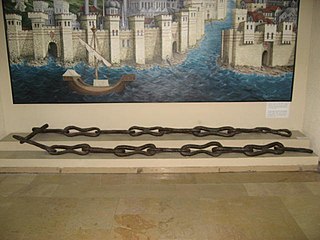 W
WThe old Tower of Galata was a tower which stood on the north side of the Golden Horn in Constantinople, inside the citadel of Galata. The tower marked the northern end of the great chain, which was stretched across the mouth of the Golden Horn to the Tower of Eugenius to prevent enemy ships from entering the harbor. The tower contained a mechanism of elevation gears for raising and lowering the chain.
 W
WThe Golden Horn Metro Bridge is a cable-stayed bridge along the M2 line of the Istanbul Metro, spanning the Golden Horn in Istanbul, Turkey. It connects the Beyoğlu and Fatih districts on the European side of Istanbul, and is located between the Galata Bridge and Atatürk Bridge, approximately 200 m (660 ft) east of the latter. It is the fourth bridge across the Golden Horn and entered service on February 15, 2014. The bridge enables a direct connection between the Hacıosman metro station in the Sarıyer district, with the Yenikapı transport hub in the Fatih district
 W
WGül Mosque is a former Eastern Orthodox church in Istanbul, Turkey, converted into a mosque by the Ottomans.
 W
WHaliç is a station on the M2 line of the Istanbul Metro. It is a part of the Golden Horn Metro Bridge and is located between the districts of Fatih and Beyoğlu above the Golden Horn. The station was opened on 15 February 2014 as part of the line's extension to Yenikapı Transfer Center. The station is accessible from both sides of the Golden Horn via pedestrian walkways adjacent to the bridge. Haliç has two side platforms, one for each direction. İETT bus service can be accessed on both sides of the bridge from Tersane Street on the Beyoğlu side and Abdülezelpaşa Street on the Fatih side. Haliç is the only station on aboveground at the line.
 W
WHaliç Bridge is a highway bridge on the Golden Horn in Istanbul, Turkey. It connects the neighborhoods of Ayvansaray in the southwest and Halıcıoğlu in the northwest. The bridge carries the O-1 motorway, also known as the Istanbul Inner Beltway. It was constructed between 1971 and 1974, and entered service on 10 September 1974. The engineering firms which undertook the construction works were IHI Corporation of Japan and Julius Berger-Bauboag AG of Germany. The bridge has a length of 995 m (3,264 ft), a width of 32 m (105 ft), and a height of 22 m (72 ft) above sea level.
 W
WHasköy is a quarter (semt) on the northern bank of the Golden Horn in Beyoğlu, Istanbul, Turkey. It includes the officially defined neighborhoods (mahalleler) of Keçeci Piri, Piri Paşa, and Halıcıoğlu, and parts of Camiikebir and Sütlüce.
 W
WThe Imperial Arsenal was the main base and naval shipyard of the Ottoman Empire from the 16th century to the end of the Empire. It was located on the Golden Horn in the Ottoman capital, Constantinople.
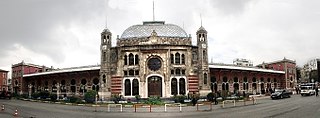 W
WSirkeci railway station, listed on maps as İstanbul railway station, is a railway terminal in İstanbul. The terminal is located on the tip of İstanbul's historic peninsula right next to the Golden Horn and just northwest of Gülhane Park and the Topkapı Palace. Sirkeci Terminal, along with Haydarpaşa Terminal on the other side of the Bosphorus, are İstanbul's two intercity and commuter railway terminals. Built in 1890 by the Oriental Railway as the eastern terminus of the world-famous Orient Express, Sirkeci Terminal has become a symbol of the city. As of 19 March 2013, service to the station had been indefinitely suspended due to the rehabilitation of the existing line between Kazlıçeşme and Halkalı for the new Marmaray commuter rail line. On 29 October 2013, a new underground station opened to the public and is currently serviced by Marmaray trains travelling across the Bosphorus. Sirkeci Terminal has a total of 4 platforms with 7 tracks. Formerly, commuter trains to Halkalı would depart from tracks 2, 3 and 4 while regional trains to Kapıkule, Edirne and Uzunköprü along with international trains to Bucharest, Sofia and Belgrade would depart from tracks 1 and 5.
 W
WThe Italian Synagogue, also known as Kal de los Frankos, is a synagogue located north of the Golden Horn in Istanbul, Turkey. The synagogue was established by the Italian Jewish community of Istanbul,, in the 19th century. In 1931 the original building was demolished and a new synagogue was built in its place.
 W
WJewish Museum of Turkey is a cultural center established by the Quincentennial Foundation to inform the society of the traditions and history of Turkish Jewry. It was inaugurated on November 25, 2001. The Quincentennial Foundation was established in 1989 by 113 Turkish citizens, Jews and Muslims alike, to celebrate the five hundredth anniversary of the arrival of Sephardim to the Ottoman Empire. The idea of a museum was proposed by Naim Güleryüz who is now its curator and the foundation was financed by the prominent Jewish Kamhi family.
 W
WKâğıthane or Glykà Nerà is an area of Istanbul, Turkey. Formerly a working class district, it has become one of the largest real estate development areas in the city. The district is located on the European side and extends over the shores of Cendere, the stream that discharges into the Golden Horn. The Cendere Valley is surrounded by the Sarıyer, Eyüp, Şişli, Beşiktaş, and Beyoğlu districts. The mayor is Fazlı Kılıç of Ak Parti. Kâğıthane was part of Beyoğlu until 1954 and part of Şişli between 1954 and 1987.
 W
WThe Karaite Synagogue is a Kenesa in the Hasköy district of Beyoğlu, Istanbul, Turkey. The building's date of construction is unclear; it may date to Byzantine times. The building was in ruins in the sixteenth century; it was repaired in 1536, burned in 1729, rebuilt, burned again in 1774, rebuilt between 1776 and 1780, restored in 1842, and burned again in 1918. The Karaite congregation of the town also has their own cemetery. The trust behind these Institutions is called Hasköy Türk Karaim Musevi Sinagogu Vakfı. Today the Kenesa functions only at the Karaite Pesach. Contact to the congregation can be built via the Turkish Chief Rabbinate or the Quincentennial Foundation Museum of Turkish Jews.
 W
WKaraköy, the modern name for ancient Galata, is a commercial quarter in the Beyoğlu district of Istanbul, Turkey, located at the northern part of the Golden Horn mouth on the European side of Bosphorus.
 W
WMaalem Synagogue is a synagogue located on the slopes overlooking the Golden Horn near the Jewish old age home in the Hasköy district of Istanbul, Turkey. It is the only remaining open synagogue in an area that once had many Jewish residents. The synagogue is open for visits only during weekdays. Shabbat services are held regularly.
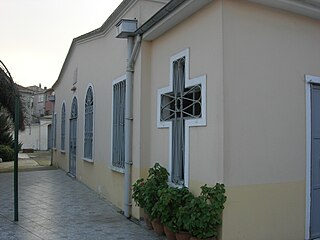 W
WSaint Mary of Blachernae is an Eastern Orthodox church in Istanbul. The little edifice, built in 1867, got the same dedication as the shrine erected in this place in the fifth century which, until its destruction in 1434, was one of the most important sanctuaries of Greek Orthodoxy.
 W
WSaint Mary of the Mongols (full name in Greek: Θεοτόκος Παναγιώτισσα or Παναγία Μουχλιώτισσα ; Turkish name: Kanlı Kilise, is an Eastern Orthodox church in Istanbul. It is the only remaining Byzantine church of Constantinople that has never been converted to a mosque, always remaining open to the Greek Orthodox Church.
 W
WMayor Synagogue is a former synagogue in the Hasköy district of Beyoğlu, Istanbul, Turkey.
 W
WMiniatürk is a miniature park situated at the north-eastern shore of Golden Horn in Istanbul, Turkey. It was opened May 2, 2003. Miniatürk covers a total area of 60,000 square metres (650,000 sq ft). It is one of the world's largest miniature parks with its 15,000 m2 (160,000 sq ft) model area. The park contains 122 models in 1:25 scale. It contains structures from in and around Turkey, as well as interpretations of historic structures.
 W
WThe New Mosque (Turkish: Yeni Cami, Turkish pronunciation: [jeni dʒami], originally named the Valide Sultan Mosque and later New Valide Sultan Mosque after its partial reconstruction and completion between 1660 and 1665, is an Ottoman imperial mosque located in the Eminönü quarter of Istanbul, Turkey. It is situated on the Golden Horn, at the southern end of the Galata Bridge.
 W
WPhanar Greek Orthodox College or Phanar Roman Orthodox Lyceum, known in Greek as the Great School of the Nation, is the oldest surviving and most prestigious Greek Orthodox school in Istanbul, Turkey. The school, like all minority schools in Turkey, is a secular school.
 W
WThe Rahmi M. Koç Museum is a private industrial museum in Istanbul, Turkey dedicated to the history of transport, industry and communications. Rahmi M. Koç, member of the wealthiest dynasty in Turkey and retired chairman of the Koç Group, founded the museum in 1991, which was opened on December 13, 1994. The museum is located in the suburb of Hasköy on the northern shore of the Golden Horn and situated in two historical buildings connected to each other. It is open to public every day except Monday. The museum's general manager is Ertuğrul Duru.
 W
WThe Rezan Has Museum is a private museum in Istanbul, Turkey dedicated to culture and arts. Ahu Has daughter in law of the philanthropist Turkish businessman Kadir Has, founded the museum in May 2007. The museum is named after Rezan Has, wife of Kadir Has.
 W
WThe SantralIstanbul, opened in 2007, is an arts and cultural complex located at the upper end of Golden Horn in the Eyüp district of Istanbul, Turkey. The center, consisting of an energy museum, an amphitheater, concert halls and a public library, is situated within the Silahtarağa campus of Istanbul Bilgi University that was formerly the first power station of the Ottoman Empire.
 W
WThe Silahtarağa Power Station was a coal-fired generating station located in Istanbul Turkey. The Ottoman Empire's first power plant, it was in use from 1914 to 1983. The site has since been converted into a university campus for the Istanbul Bilgi University and houses two museums and several facilities. It was refurbished and renamed SantralIstanbul in 2007.
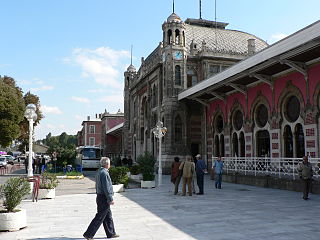 W
WSirkeci is a quarter in the Eminönü neighborhood of the Fatih district of the city of Istanbul, Turkey. The neighborhood borders to the North the mouth of the Golden Horn, to the West the neighborhood of Bahçekapı, to the East the Topkapi Palace area, and to the South the Cağaloğlu neighborhood. Sirkeci hosts Sirkeci Station, the Southeastern long distance passenger train terminus in Europe for the Orient Express.
 W
WThe Spice Bazaar in Istanbul, Turkey is one of the largest bazaars in the city. Located in the Eminönü quarter of the Fatih district, it is the most famous covered shopping complex after the Grand Bazaar.
 W
WSütlüce is a neighborhood in the Beyoğlu district of Istanbul, Turkey, located at the eastern bank of Golden Horn across Eyüp.
 W
WToklu Dede Mosque, was an Ottoman mosque in Istanbul, Turkey. The building was originally a Byzantine Eastern Orthodox church of unknown dedication. It was almost completely destroyed in 1929.
 W
WYambol Synagogue is a synagogue in Istanbul, built by Sephardi Jews who moved from the Bulgarian town of Yambol to Istanbul during the 15th century. The synagogue is also known as the Bulgarian Synagogue owing to the origin of the community. The synagogue was constructed in the 18th Century. However, it underwent repairs during the end of the 19th century thus the structure today is not the original. Today, the synagogue is only open for Shabbat services due to a decrease in the Jewish community in the area.